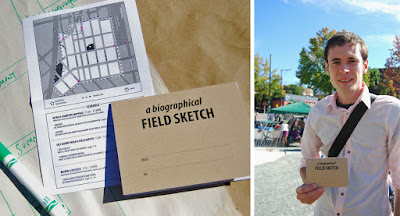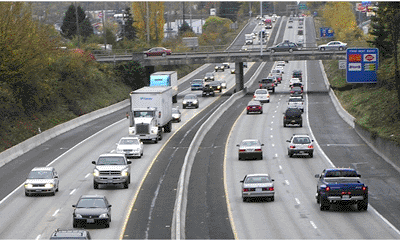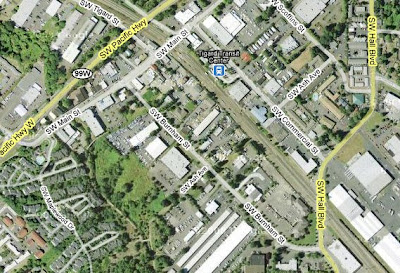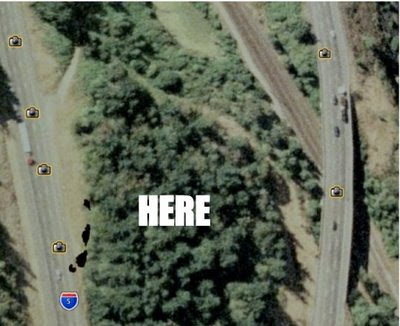 Last Friday, Christa, Julia and I organized a small BRITE event to take part in global PARK(ing) Day where hundreds of temporary mini parks were set up in actual parking spots or unused lots all around the world.
Last Friday, Christa, Julia and I organized a small BRITE event to take part in global PARK(ing) Day where hundreds of temporary mini parks were set up in actual parking spots or unused lots all around the world.
We were part of a bigger lot that used to be an old hipster stomping ground - former home of the Cha Cha, Bimbo's Burritos, etc. (On Pine between Summit & Belmont)
Now it's just an empty gravel lot, since after they tore down the whole block, the recession hit...
The PARK(ing) day was a day to give the community a reason to hang out there again....and we couldn't have asked for any better weather. The Negative Space field sketch was inspired from a walk that Julia, Dylan and I did awhile back in July when we walked around Burien....yeah, that's right...Burien. Who would of thought anyone can spend that much time just wondering around, right? But after 2 hours of walking around, we left with thoughts and questions about other neighborhoods, and realized really how little we know and notice on an everyday basis....We were inspired to do other walks such as this.
The Negative Space field sketch was inspired from a walk that Julia, Dylan and I did awhile back in July when we walked around Burien....yeah, that's right...Burien. Who would of thought anyone can spend that much time just wondering around, right? But after 2 hours of walking around, we left with thoughts and questions about other neighborhoods, and realized really how little we know and notice on an everyday basis....We were inspired to do other walks such as this. We wanted to take the opportunity on the PARK(ing) Day to get people to slow down and take a look at the Capitol Hill neighborhood.
Especially in an area that has so much history, people (the densest residential area on the west coast north of SF), various types of businesses, and landscape, this neighborhood has gone through some major changes in the last 5 years (and still in the process of). Some more controversial than others. While many of these issues have been presented as the good locals vs. evil developers, there has been many great positive improvements such as the Cal Anderson park which has quickly became a common landmark for most residence/students/professional in the neighborhood to hangout.
 As we walked we asked ourselves these provocative questions:
As we walked we asked ourselves these provocative questions:
*How have all the changes effected everyone's connection and perception about the area....are they positive/negative? neither/both?
*With each change that happens, how has it effected one's knowledge, perceptions, memories, feelings, and their use of a certain area? (i.e. excavating of the old Cha Cha lot vs. the creation of Cal Anderson park)
*How do each of those elements tie into the way we associate with a place?...whether it be 4 block radius or a neighborhood, the city, or the entire country.
*How do we, as an individual make a place more pleasant for ourselves...and if possible, for others?
People participated on different levels depending on the time allowed. Many came by to say hello or during their lunch breaks to draw up some quick cognitive memory maps of what they knew about the area. Here's a whole line of maps hung up.  For those who had more time, we then gave them each a special "biographical field sketch book" as they went on a self-guided walk, jotting down what they noticed.
For those who had more time, we then gave them each a special "biographical field sketch book" as they went on a self-guided walk, jotting down what they noticed.
Constance's conclusion: Pay Attention. (Constance came back and admitted that she spent half the walk looking for her car trying to feed the meter and got even more turned around) Jonhathan's Field Sketch: Great old buildings. (as an architect, he appreciates the old charming buildings of Capitol Hill)
Jonhathan's Field Sketch: Great old buildings. (as an architect, he appreciates the old charming buildings of Capitol Hill) Jean's Findings: Great mix of pattern & texture that reminded me of Italy.
Jean's Findings: Great mix of pattern & texture that reminded me of Italy.
(I went on a walk myself and wandered around for 45min taking notes as well as photos. It was nice to just walk without having to get to any place....it was as if I was visiting Capitol Hill for the first time. We even got some young BRITE participants! How cute!
We even got some young BRITE participants! How cute!
 Below are some other great mini-parks on the lot that day:
Below are some other great mini-parks on the lot that day:
Below is an "Air" Park A giant connect four, a table to make some art, Flash Volunteer, and a ping-pong table.
A giant connect four, a table to make some art, Flash Volunteer, and a ping-pong table.
For the fact that it was a working day, the turnout was better than we had anticipated. We were just happy to see people out and about and actually showing support. Granted we couldn't get people to start the walk all at the same time, it was still a good trial run and a learning experience nonetheless. We hope that we can do this on a time of the day so more people can attend in the future and perhaps even do other less popular neighborhood walks like Int'l District, First Hill, Judkin's Park, Lake City...and many many more!)
Check out the Flickr set for more photos of the event and people's field sketch notes!
If you like to join BRITE's mailing list to hear about our updates, please leave a message with your email on our Facebook page.
Viewing entries tagged
urban planning
Collectively, Jean and I have lived in Seattle almost 27 years...not a once have we even had the slightest reason or desire to go to Burien, a suburban city near the airport about 15 miles south of the downtown Seattle. From an ignorant city slicker's perspective, Burien and anywhere around it embodies suburban sprawl. We got off the free way, and saw this...and thought "yup...yet another wide congested streets, endless rows of big box stores and uninspiring neighborhoods of cookie cutter houses...."
Our preconceptions were challenged however by the concepts of Thomas Seiverts. Following his lecture, we decided to join Thomas and Boris (his son), Matthew Stadler of suddenly.org, and a good size group of strangers in the city of Burien for a neighborhood walk as a textbook example of how we can begin to rethink the aesthetics of urban sprawl.
As we arrive at the meeting point, we saw a giant open parking lot next to Staples...oh boy...  Needless to say, we were pleasantly surprised by the simple wonders this suburban site has to offer. The 2 hour walking tour consisted of a loosely directed rout, a map, and conversations at varoius check points to stop and share some thoughts between everyone.
Needless to say, we were pleasantly surprised by the simple wonders this suburban site has to offer. The 2 hour walking tour consisted of a loosely directed rout, a map, and conversations at varoius check points to stop and share some thoughts between everyone.As we started the walk, it took us a little time to first get acquainted with people and get in the zone of looking at things. But as time went, we gradually shifted to our traveling mode...where we started to wonder around with others and explore the alleys and side streets. We absorbed every little thing in our surroundings, stopped every other second to look at something closer or take photos, and even talk to strangers! All those things are so out our norm on a daily bases unless we're traveling somewhere far...but little did we know that pretending to be travelers in our own city can be this enjoyable and stimulating.
 So, here's our top 5 reasons why we're reformed:
So, here's our top 5 reasons why we're reformed:1. Alleys: According to a member of our group, many of Burien's alleys were created early in its settlement...the more streets the town appeared to have, the more enticing it was to railway development. In modern times, unassuming alleys in the town are bustling with the activities of mixed-shared use. A central alley off the main street houses the back side of commercial areas: restaurant workers hanging out on break and the olde feed store's garage door open to reveal surprise chickens and haystacks. As the alley continued into the residential area, people customized their spaces without fencing off their property revealing beautiful gardens (with more chickens!), backyard bbq's, and abandoned backyard projects. You rarely think to walk down alleys, but they are really visually rich areas.
2. Repetition towards "Aesthetics": One of the big themes in Sievert's theories is the inhabitant's tendency towards adding aesthetic elements to make the landscape their own. One of our most striking observations of this is that there was lots of repetition in the Burien cityscape: newer "more attractive" traffic lights were being put up directly next to perfectly good utilitarian ones, boring signs were repeated with brightly colored versions of the same thing, better looking fences were put up directly in front of less desirable, but effective counterparts. People definitely have the natural urge to beautify their space, we just need to be more deliberate about allowing that to happen.
3. Original Character: Burien has a pretty sweet downtown strip. Not only are there tastefully done new condos and retail shops going up (including a great coffee shop called Burien Press) but there are plenty of un-gentrified quaint shops and cafes(Kirk's feed, old time patriotic barber shop) and original 1950's main street architecture (many vacant but formerly home to jewelry stores and trophy shops) that add to it's charm and history.

4. Unpretenous art scene: The city tour began and ended at the Burien Interim Art Space (B/IAS), which is a temporary public art space created in an empty parking lot outside of the Staples super store. The area was slatted for development, but as the project was put on hold the community banded together and convinced the builder to allow it to be a temporary open-air art space. In between artfully carved up asphalt (the parking lot was selectively broken up to reveal the dirt below) B/IAS houses several burning man sculptures plus a small pea patch! There is also the Burien Arts Gallery situated in a lovely small house above Burien Park, which is beginning to break ties with it's seascape-watercolor-painting past and bring in contemporary works from Seattle and beyond.
5. Unafraid of Fine Dining In a Staple's Parking lot: Burien appears almost unapologetic about it's identity, which is impressive in its own right. While it has some developed character, it is mixed bittersweet with soulless big box stores, roaring traffic, and run-down fringes. The city wears it all well and according to Sievert's ideas is well poised to gracefully accept a future of increased localization and need for community resourcefulness. We were just happy to be there to witness what it has to offer here and now and to enjoy a great conversation and a delicious (and free!) meal in looming shadow of Staples.
All and all, this simple walking tour was an experience that left more than just an impression. We walked away from the tour with new inspirations, new connections, and the feeling of optimism. Pretty amazing for a suburb town. Next time when we're feeling the travel itch, we'll just head down to Burien instead!
See more photos and commentary on Flickr.
When was the last time you stopped to appreciate the most mundane parts of where you live?
Have you ever hike along the woods off the highway?
Can fences be used to connect instead of divide? These are a few of the questions brought up in a lecture Jean and I attended tonight by urban planner Thomas Sieverts and put on by Portland-based Suddenly.org.
These are a few of the questions brought up in a lecture Jean and I attended tonight by urban planner Thomas Sieverts and put on by Portland-based Suddenly.org.
Thomas's theory is that we need to come to terms with the already established sprawl of our urban environments and recognize the inherent charm and potential in the in-between state of being it creates. His suggestion is that we begin to shape our culture in a way that appreciates and enhances interactions of people with their location.
-How can we make the best out of the situation and be better aware of and enjoy the places we live?
-Can spaces between buildings become spots for gardens or for people to mingle?
-Can big commercial businesses use the parking lots to house community events like flea markets, fairs, or skateboard competitions? Thomas posed these questions and more through a narrative photo tour through a Tigard, OR, an apparent suburban wasteland (similar to Burien, WA) of big box stores, fast food, and lower-middle class residences. The photos highlighted the hidden beauty of forests situated between strip malls, spaces between buildings, unofficial walkways, and well-intentioned. Some were beautiful examples spontaneous human resourcefulness others audacious attempts to insert "beauty" in an altogether bland location (think trimmed hedges in parking lots...what's the point?). All were scenes you could witness if you'd just notice it or take a thoughtful walk around a neighborhood near you....or keep it simple and get your ass out of the car. :D
Thomas posed these questions and more through a narrative photo tour through a Tigard, OR, an apparent suburban wasteland (similar to Burien, WA) of big box stores, fast food, and lower-middle class residences. The photos highlighted the hidden beauty of forests situated between strip malls, spaces between buildings, unofficial walkways, and well-intentioned. Some were beautiful examples spontaneous human resourcefulness others audacious attempts to insert "beauty" in an altogether bland location (think trimmed hedges in parking lots...what's the point?). All were scenes you could witness if you'd just notice it or take a thoughtful walk around a neighborhood near you....or keep it simple and get your ass out of the car. :D Billboard on I-5 between Seattle and Portland. It's always changing with some ridiculous messages on it. I love reading it every time we go by.
Billboard on I-5 between Seattle and Portland. It's always changing with some ridiculous messages on it. I love reading it every time we go by. Playful signs on a roundabout by Hiawatha neighborhood off of S Rainer Ave in Seattle.
Playful signs on a roundabout by Hiawatha neighborhood off of S Rainer Ave in Seattle.
The point behind it all is that there's a natural desire to express human needs no matter the location and that we all need to recognize them and demand them, but it's also what we choose to see and appreciate what's around us.
Will there come a time where living in an abandoned strip mall or Costco building is just as desirable as livinging in industrial warehouses? This whole lecture has opened up so many design potentials on this subject, and our heads are spinning with ideas for Brite!!...... oh boy!
This whole lecture has opened up so many design potentials on this subject, and our heads are spinning with ideas for Brite!!...... oh boy!
Today July 2nd: Continuing event with Thomas Sieverts : there will be an organized walking tour in Burien neighborhood to practice this exact philosophy we described and explore what's around there. When's the last time you decided to stop and walk around Burien?? We can't say that we have....But we will tomorrow!
4:00 pm Burien through Community Eyes: Walk the city of Burien with Thomas Sieverts and artist, Boris Sieverts. (Gather at B/IAS 5th Ave SW & SW 150th St., Burien.) Free and open to the public.
6:00 pm Conversation and Nosh with Thomas Sieverts and Boris Sieverts, Burien political and civic leaders, neighbors, friends, and an interested public (at B/IAS, 5th Ave SW & SW 150th St., Burien; food and drink from Mark & Sal’s Deli). Free and open to the public.
 There's a series of really interesting events happening in Seattle this week from July 1st-3rd concerning the idea of urban planning specifically in Seattle and Burien (interesting combo). Occasioned by Thomas Sieverts, there will be discussions, film showings, and exhibits surrounding this topic.
There's a series of really interesting events happening in Seattle this week from July 1st-3rd concerning the idea of urban planning specifically in Seattle and Burien (interesting combo). Occasioned by Thomas Sieverts, there will be discussions, film showings, and exhibits surrounding this topic.
Suddenly Presents: Sieverts in Seattle and Burien, July 1-3, 2009
Our cities surprise and confound us by scrambling the categories we
use to plan and understand them. At once dense and sprawling, crowded
and empty, urban but centerless, dynamic and stalled, the landscape
where we live defies planning and leaves us with little grasp of its
meanings or pleasures. Yet it is the product of our choices,
individually and as a public: we live here now. So, what can we make
of it? Suddenly will bring art and food and public conversation to
bear on the common cause of making meaning and life in the landscape
where we live now — as it is, as we are, as best we can.
We're thinking of checking these events below:
Wednesday July 1
7:30 pm “Urban Aesthetics,” lecture by Thomas Sieverts (at Town Hall, 1119 8th Ave., Seattle, $5 suggested donation)
Friday July 3: (if you can splurge...this dinner sounds really amazing)
Corridor Project closing dinner at 6pm hosted by Michael Hebb,with Matthew Stadler and Thomas Sieverts in conversation, including a celebration of “suddenly: where we live now, the visual chronicle;” (see www.onepot.org for details). It's $40 for the dinner The documentation of the Corridor Project IIII: Habitat: will be on display. The opening of the Exhibition is open to the public and begins at 9pm in Occidental Plaza in Pioneer Square.
The documentation of the Corridor Project IIII: Habitat: will be on display. The opening of the Exhibition is open to the public and begins at 9pm in Occidental Plaza in Pioneer Square.
Corridor Project IIII is an exploration of the wilderness and landscape of the Interstate 5. Michael Hebb, Hannes Wingate and Michael McManus discovers what it means to live, eat, and create a habitat for 3 days in one of the freeways generous median areas. (crazy!!)
